

SS Cap Arcona
Hamburg Süd
1927 - 1945
Hamburg Süd
1927 - 1945
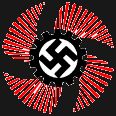

Sierra Cordoba Photo Album - 1934 / 1935
Voyage Photos: 104
Voyage Photos: 104


Der Deutsche Photo Album - Also features the Bremen, Milwaukee, and Oceana.
May 6th, 1937
Photos: 34.
The album also has 56 newspaper clippings / photos cut out during the war. Most of these are AP photos of various ships sinking, burning, picking up survivors, & bomb blasts. Several of the newspaper articles can be viewed below under the last PDF file.
May 6th, 1937
Photos: 34.
The album also has 56 newspaper clippings / photos cut out during the war. Most of these are AP photos of various ships sinking, burning, picking up survivors, & bomb blasts. Several of the newspaper articles can be viewed below under the last PDF file.
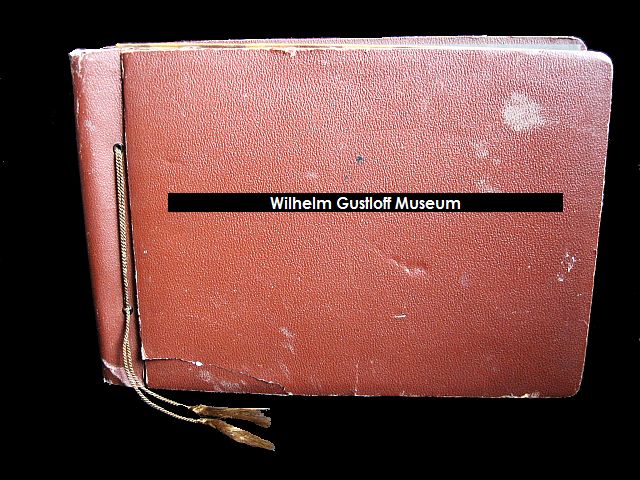
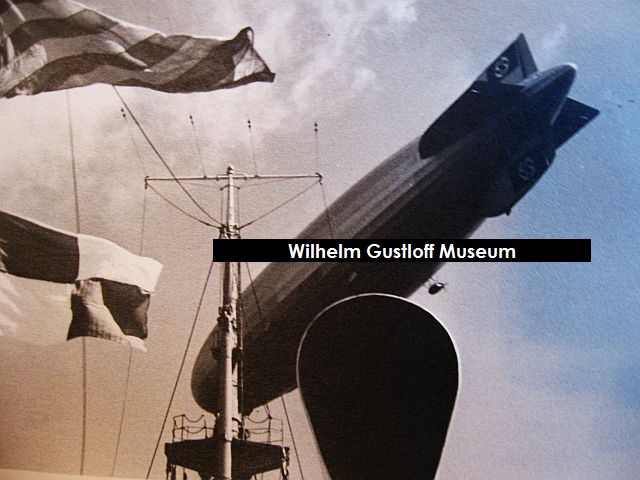
Unknown KdF Liner passing the Hindenburg at sea.
- Possibly the Oceana or Sierra Cordoba.
Beautiful images of the great airship over the ocean.
- Possibly the Oceana or Sierra Cordoba.
Beautiful images of the great airship over the ocean.
Photo #1: Likely the British battleship HMS Nelson.
Photo #13: The German Panzerschiff Deutschland.
Photo at Right: Colorized Hindenburg photo.
Photo #13: The German Panzerschiff Deutschland.
Photo at Right: Colorized Hindenburg photo.


While not related to the Wilhelm Gustloff - this film is related to another great ship, the Cap Arcona.
Titanic was a 1943 Nazi propaganda film made during World War II in Berlin by Tobis Productions for UFA, which was later banned from Nazi Germany by Propaganda Minister Joseph Goebbels. The film used the sinking of the RMS Titanic as a setting for an attempt to discredit British and American capitalist dealings and glorify the bravery and selflessness of German men. The film is known for its extremely dark production history and, ironically, became the symbol of the corruption and "sinking" of the Third Reich itself.
The film was shot on board the SS Cap Arcona, a passenger cruise ship which itself was sunk in the last weeks of World War II with a loss of life far heavier than that on the actual Titanic. The scenes with the lifeboats were filmed on the Baltic Sea and some of the interior scenes were shot in Tobis Studios.
In 1992, a censored, low quality VHS copy, (shown here) was released in Germany. This version deleted the strongest propaganda scenes, which immensely watered down its controversial content. Finally, in 2005, Titanic was completely restored and, for the first time, the uncensored version was released in a special edition DVD by Kino Video. Source: Wikipedia: Titanic (1943 Film).
The full version with English subtitles can be found on YouTube for those interested in watching it.
Titanic was a 1943 Nazi propaganda film made during World War II in Berlin by Tobis Productions for UFA, which was later banned from Nazi Germany by Propaganda Minister Joseph Goebbels. The film used the sinking of the RMS Titanic as a setting for an attempt to discredit British and American capitalist dealings and glorify the bravery and selflessness of German men. The film is known for its extremely dark production history and, ironically, became the symbol of the corruption and "sinking" of the Third Reich itself.
The film was shot on board the SS Cap Arcona, a passenger cruise ship which itself was sunk in the last weeks of World War II with a loss of life far heavier than that on the actual Titanic. The scenes with the lifeboats were filmed on the Baltic Sea and some of the interior scenes were shot in Tobis Studios.
In 1992, a censored, low quality VHS copy, (shown here) was released in Germany. This version deleted the strongest propaganda scenes, which immensely watered down its controversial content. Finally, in 2005, Titanic was completely restored and, for the first time, the uncensored version was released in a special edition DVD by Kino Video. Source: Wikipedia: Titanic (1943 Film).
The full version with English subtitles can be found on YouTube for those interested in watching it.
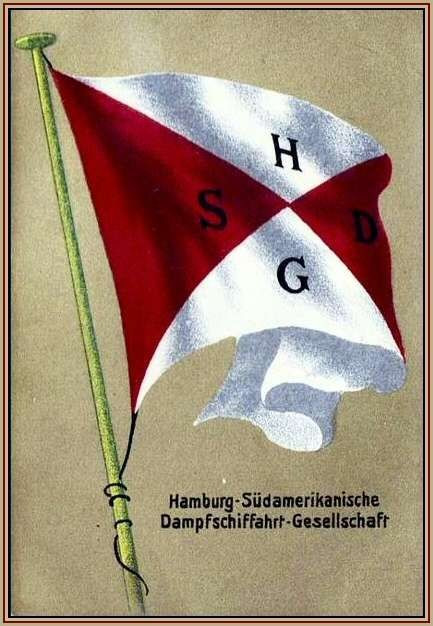
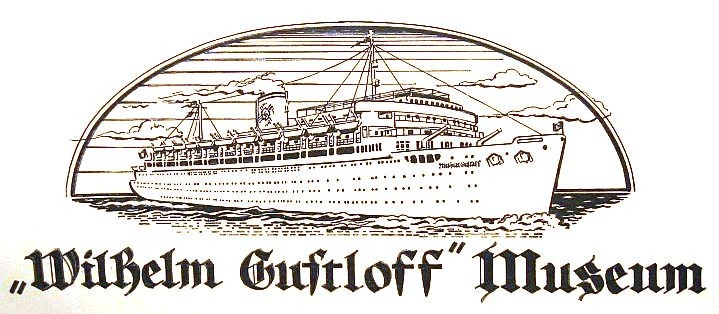

If the Wilhelm Gustloff and Robert Ley are my first loves, the Cap Arcona comes in third. Built by Blohm + Voss in 1926 and launched in 1927, she was the flagship of the Hamburg Südamerikanische Dampfschifffahrts-Gesellschaft (Hamburg-South America Line or HSDG) fleet. Her statistics were:
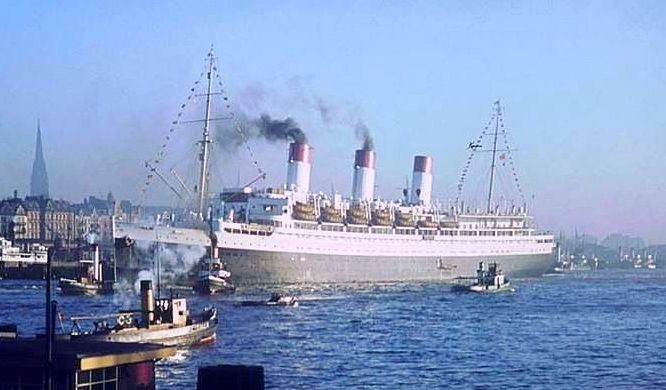
Length: 675 ft
Width: 84 ft
Tonnage: 27,561
Engines: 8 steam turbines
Speed: 20 knots
Lifeboats: 26
Maiden Voyage: Nov 19, 1927
Range: 12,790 miles
Width: 84 ft
Tonnage: 27,561
Engines: 8 steam turbines
Speed: 20 knots
Lifeboats: 26
Maiden Voyage: Nov 19, 1927
Range: 12,790 miles
Passenger capacity:
From 1927: 575 1st class, 275 2nd class, 465 in dormitories; total 1,315
From 1927: 575 1st class, 275 2nd class, 465 in dormitories; total 1,315
From 1937: Total 850
Crew: 475
Nicknames: Queen of the South Atlantic, The Floating Palace
Crew: 475
Nicknames: Queen of the South Atlantic, The Floating Palace
1 - The launching of the Cap Arcona in 1926.
2 - 6 - Postcard views of the Cap Arcona.
7 - Passenger Cabin
8 - Postcard set cover.
9 - Through the Festival Hall
10 - Passage to the Festival Hall
11 - Smoking Lounge
12 - Smoking Lounge in color from Alamy.
13 - Festival Hall
14 - Wintergarden
15 - Wintergarden in color from Alamy..
16 - Dining Room
17 - Hall
18 - Swimming Pool
19 - Sports Deck
2 - 6 - Postcard views of the Cap Arcona.
7 - Passenger Cabin
8 - Postcard set cover.
9 - Through the Festival Hall
10 - Passage to the Festival Hall
11 - Smoking Lounge
12 - Smoking Lounge in color from Alamy.
13 - Festival Hall
14 - Wintergarden
15 - Wintergarden in color from Alamy..
16 - Dining Room
17 - Hall
18 - Swimming Pool
19 - Sports Deck
While I was always aware of the Cap Arcona and her story, what finally made me decide to dedicate a page to her was the book "The Nazi Titanic" by Robert P. Watson. I read this book twice while on vacation and became so enthralled with the liner, I soon found myself searching online for physical artifacts from the ship and wreck. (This was a fantastic book, but there were several inaccuracies in the Wilhelm Gustloff chapter). For the most famous ocean liner in the German fleet for 18 years, there is surprisingly little on her aside from the sailing views and souvenir postcards shown above. Most internet searches direct you to stories of her gruesome end, and there are almost no photographs or albums from aboard the ship available to view. Shown above below is my current Cap Arcona artifact and memorabilia collection:
Cap Arcona Photo Album
Voyage to Rio de Janeiro & Buenos Aires
March 1938
Voyage to Rio de Janeiro & Buenos Aires
March 1938
The biggest thing about the Cap Arcona that surprised me is after days of searching, I could not find any photos or albums taken on one of her regular South American voyages. I found one website which had a handful of photos of passengers and crew on the decks and with a life ring, but that was it. When I came across this album for sale, I snapped it up immediately. Of the 230 photographs, the album begins with photos from her voyage and includes 3 cut and glued cap tallies from the ship. Photos show the passengers playing tennis and dancing on the liner, along with several port and harbor views. There are also 2 souvenir postcards and a card which Captain Niejahr sent to request passengers for cocktail hour. The album ends with several random photos and large full page photos of people hunting. Interestingly enough, all the captions are in English. I decided to just post all of the photographs relating to the ship below.
Notable Photos:
5 & 6 - These are fantastic because they not only show passengers enjoying themselves dancing in the ship's ballroom, but you can clearly see the styles of HSDG glassware and silver used on the tables.
6 - The names Joanna & Jimmy James.
12 - Herr Schroeder
16 - The Conte Grand in Montevideo.
22-24 - Equator crossing celebration on deck.
5 & 6 - These are fantastic because they not only show passengers enjoying themselves dancing in the ship's ballroom, but you can clearly see the styles of HSDG glassware and silver used on the tables.
6 - The names Joanna & Jimmy James.
12 - Herr Schroeder
16 - The Conte Grand in Montevideo.
22-24 - Equator crossing celebration on deck.
Cap Arcona Menu
September 26th, 1934
Equator-crossing Festival
September 26th, 1934
Equator-crossing Festival
German Reich Sailor's Discharge Book #4 - Issued in Hamburg, 9/4/ 1930
This Sailor's Log Book comes from steward Pierre Cyrus: Born April 9th, 1892. His log book also starts with the Wilhelm Gustloff's very first sea trial voyage stamped inside - March 14th, 1938. His records for the Cap Arcona are as follows:
This Sailor's Log Book comes from steward Pierre Cyrus: Born April 9th, 1892. His log book also starts with the Wilhelm Gustloff's very first sea trial voyage stamped inside - March 14th, 1938. His records for the Cap Arcona are as follows:
Cap Arcona - 1/23/35 to 5/21/35
Cap Arcona - 12/20/35 to 1/8/36 - Signed Bertram, I Officer.
1 - WW2 U.S. Army Air Force Ship Identification Slide - Cap Arcona.
2 - The Cap Arcona with the New York in Gotenhafen just after the war's beginning. She is still in her ocean liner colors.
3 - Her hull still black, her funnels appear all white.
4 - Circa 1943.
5 - Circa 1943.
6-8 - Now in all dark gray paint, c 1944.
9 - Circa 1943. This photo was around the time her funnels were repainted standard colors for the filming of the movie Titanic.
10 - A souvenir cane badge of the Cap Arcona.
11 - (Right) A color slide of the Cap Arcona in Gotenhafen early during the war c1939/1940. Internet sourced photograph.
2 - The Cap Arcona with the New York in Gotenhafen just after the war's beginning. She is still in her ocean liner colors.
3 - Her hull still black, her funnels appear all white.
4 - Circa 1943.
5 - Circa 1943.
6-8 - Now in all dark gray paint, c 1944.
9 - Circa 1943. This photo was around the time her funnels were repainted standard colors for the filming of the movie Titanic.
10 - A souvenir cane badge of the Cap Arcona.
11 - (Right) A color slide of the Cap Arcona in Gotenhafen early during the war c1939/1940. Internet sourced photograph.
So The Cap Arcona Sank.
German newspaper article from between 1950 and 1954.
By: Heinrich Lietz
On May 3, 1945 in the evening hours, one of the largest ships of the then German merchant navy sank in the Neustädt Bay - the "Cap Arcona", a luxury steamer of the "Hamburg-South American Steamship Company". There were over five and a half thousand people on board. Hardly more than 500 could be saved. At the same time, the "Thielbeck" with 2,500 inmates sank alongside of the "Cap Arcona", of which only 20 could be rescued. Little was known about this horrific drama in the last days of the war today, after the events of the collapse of the Third Reich overshadowed everything else.
The dawn of doom lies over Hitler's Germany! The Russian armored armaments crossed the borders of the Reich at the end of 1944. Now the tide is licking at the East Prussian Wall, damming up the Vistula and rising and rising ... The "Cap Arcona" lies on the pier of the large ocean liners in Gotenhafen. Once a jewel of the German merchant navy, the pride of its shipowners, it has been idle for a long time now. The ship, built in 1927 and weighing 27,500 tonnes, had served luxury passenger transport between Hamburg and the South American capitals Rio and Bueno Aires for ten years. No more than seven hundred passengers were accepted; but they saw themselves surrounded by every conceivable luxury. The height of the ship was 22 meters from the waterline to the bridge. With its endless promenade decks, its play and rest areas, true escapes from dining rooms, salons, music rooms, smoking rooms, libraries and ballrooms, the proud ship had once measured the waves of the Atlantic in those happy days before the outbreak of madness. Now the colossus lay on the lonely pier in the deserted harbor. In the halls and halls - dead silence, the promenade decks - swept empty. In the luxury cabins, have turned into a marine assistant school residential accommodation.
In mid-January 1945, the disaster strikes. Together with the icy blizzards of the east, the Red Army rushes into the country, driving unpredictable flows of refugees. Crowds gather in the cities. Westward - or death! is the watchword. The "Cap Arcona" also receives the order to get ready to leave. The naval assistants disappear. With 10,000 East Prussian refugees on board, without food, the ship goes to the Bay of Lübeck. The refugees are unloaded in Neustadt in Holstein. The ship should immediately go back to the east. The captain shoots himself. His successor, a man in his mid-forties who has sailed all the seas, represents the best tradition of the German merchant navy. During the war, he proved that discipline can be combined with civil courage if there is real responsibility. He knows the world beyond the German fence posts; For this reason, it has long been clear to him where the journey of the German state ship is under an inept and criminal leadership. He is also not afraid to express his views sometimes quite drastically.
After repairing a machine damage in the Neustädter Bucht the "Cap Arcona" runs to Hela, from where it brings the wounded to Copenhagen. A planned second trip is omitted: the oil consumption of the powerful ship is enormous, the situation in the east has already become too dangerous. On April 13th the "Cap Arcona" is still in Copenhagen. There comes a radio message with the command to immediately leave Neustadt. The news is received with mixed feelings: Copenhagen would have been preferable, but the quiet Neustadt Bay also offers a good chance of surviving the end of the war. Only the date of the command is embarrassing: Friday, the 13th is a very demonized constellation, according to old seaman beliefs. With a crew of 350 men, including a Navy command of 80 men, the "Cap Arcona" anchored in the bay on the evening of April 14, about 2.5 nautical miles from Neustadt. The ship itself is unarmed. The captain and crew are considered to be under military service, although they remain members of the merchant navy and wear their uniforms. According to orders, they are subordinate to the Navy. A few days of relative calm follow. The 80 marines are withdrawn, and the crew are reduced to 76 non-front-line personnel by order of the navy. The ship lies without oil with partly disassembled machine. The events of the war, in particular the stormy advance of the English towards Hamburg and Schleswig-Holstein, are followed closely. The captain goes to Hamburg to receive instructions from the shipping company.
On the second day after the captain's departure, the ship's first officer received an order from the Reich Commissioner for Maritime Affairs to clear the ship for the admission of 10,000 concentration camp prisoners. Soon afterwards the "Athens", a 3000-tonne vessel, appeared and announced that it had been ordered not to be able to carry out some 2,500 of the people on board and claimed that the captain was absent. The "Athens" goes close to anchor, but leaves the bay towards Lübeck on the second day. The captain of the "Cap Arcona" learns in Hamburg of the order intended for him and his ship. He returns quickly. On April 26, he was standing on the quay in Neustadt when an SS assault leader and his entourage approached him and asked how he could get to "Cap Arcona". When the captain reveals himself and asks why ne needs to, the SS officer, hoarse with excitement, screams to him that he has been ordered to shoot him legally, if he should refuse to keep taking the concentration camp prisoners on board. Faced with this most brutal threat of a great system, the captain backs off.
In the afternoon, the SS visits the ship. Some of their people stay on board. The "Athens" appears on April 27 and lies alongside. It brings 2,500 prisoners. The chain gang on the "Cap Arcona" flows over the gangways. They are members of 26 nations; all men from the Neuengamme concentration camp near Hamburg. Completely tired, swaying, emaciated wailing figures in prison clothes with the badges of the categories created by the SS. The next day, the second batch, worth another 2,500 men, was taken over, plus 500 men of coastal artillerymen, all older people aged 50 and over, pressed by the SS to the security service. The captain manages the accommodation himself. He cleverly knows how to ward off the worst, the crumbling of 10,000 prisoners, among other things. The occupancy of the potato cellar, a room of less than standing height. He categorically declares that he cannot take over a man over 5,000.
As a luxury passenger ship, the "Cap Arcona" has only very little cargo space. The largest group, the Russians, is housed in these fore rooms. The French follow a little further amidships. The coastal artillerymen install themselves in the centrally located large dining rooms. But all the cabins are also occupied by 12 prisoners each. Scary, grotesque finale! The concentration camp inmates in luxury cabins with bathrooms and water closets! And the rock bottom was exposed to the last, the deepest misery! Prisoners are strictly prohibited from leaving their accommodation. This command is not required, the general state of exhaustion is much too great. 126 men die within the next five days. For five days, a dead man is carried out every thirty minutes and placed on the quarterdeck. Embarkation ends on the 28th evening. There are now around 5,000 prisoners, 500 security guards, 76 crew members and a small SS commando on board. The catering question is completely unresolved, only a small amount of food was taken over from the "Athens". Absolutely inadequate amounts of water are brought in from Neustadt by boat. The kitchen of the "Cap Arcona" can supply 1,200 people in extreme cases. The problems that are suddenly piling up in front of the captain are likely to deprive him of sleep, and their effect on most of the officers and men is achingly depressing. They are seafarers who are used to helping people in need. They have hardly eaten anything in the next few days and have done their utmost to alleviate the worst suffering. It was a drop of water on the hot stone.
After delivery of her second load, the "Athens" had left for Lübeck again and returned on April 29 with another 3,000 prisoners. There is no attempt to hand this over to the "Cap Arcona". Instead, the "Athens" anchored nearby. Another ship appeared shortly afterwards, the "Thielbeck", about 3,000 tons. She had about 2,500 concentration camp prisoners on board and anchored at a distance of about 700 meters from our hooks. Together with the 22,000-ton stationary hospital ship "Deutschland" (formerly on the Hamburg - New York run), about two nautical miles further south, there were four ships off Neustadt on April 30th.
On May 1st, a tugboat with three barges deep in the water approached the "Cap Arcona". Concentration Camp Prisoners Again! This time from Danzig-Stutthof, about 1,000 people, including numerous women. Nationally predominantly Polish Jews, but also some Norwegians. The barges are leaking and take on plenty of water. After the complete impossibility of accommodating further prisoners on the "Cap Arcona" turns out, the tug steams off towards the pilot's house and puts the barges on the ground a few 100 meters to the west in the shallow water. At the same time, the captain learns that a high SS official, the deputy commandant of Neuengamme, is in Neustadt. The second officer is ordered to take him on board under all circumstances. It is made clear to him that the captain and the ship's management reject any further responsibility.
May 2, 1945. An atmosphere of extreme nervousness spreads across the entire ship. Hostile aviation has been active since early morning. Hurricanes and Spitfires fly over the ship several times. Rumors want to know that Hamburg has already fallen and that the English are standing in front of Lübeck. The whimpering of the starving Russians and Frenchmen sounds from the hatches of the foreship. There are well over 100 bodies on the quarterdeck. A yacht is organized in case the barge traffic has to be stopped completely due to lack of fuel. The "Athens" opens and runs into the port, because the conditions there have become unsustainable. In the evening, the SS commander orders the dead to be thrown overboard. The captain brusquely refuses and instructs his second officer to bring the dead ashore and arrange for a burial in the Neustädter Friedhof. The transfer by means of the barge takes place at night, the burial itself on the morning of May 3rd. At the same time the sailing yacht seized by the captain, but not ready for sailing, is brought in and moored alongside.
May 3, 1945. Cold, windy weather with changing clouds. After the excitement of the morning, the ship is relatively calm. But the tension in Neustadt has risen to the highest. The Volksstrum is called up. The mayor is informed that a bunch of concentration camp prisoners arrived on foot from Silesia. In addition, in the night from 2nd to 3rd, the 1,000 prisoners, men and women, went ashore on their own from their semi-soaked barges and begged for food , strayed through the streets of the suburbs. In the morning they are surrounded by SS and driven into the submarine school area. Aviation activity is increasing. Shortly before noon the funeral team returns on board. 2.30 p.m .: A single plane zooms in and shoots off a rocket bomb. It falls into the sea between the "Cap Arcona" and the "Thielbeck". In view of the immediate attack, the captain orders the raising of a white flag on the bridge. The SS officer disagrees.
3:00 p.m .: Approach by four enemy bombers. They hit the attack almost to the mast height. The rocket projectiles explode amidships and destroy the majority of the security teams in the dining rooms. Smoke and smoke rise from the explosion, cries for help are heard. There will be five more approaches over the next 15 minutes. From the quarterdeck to the bridge, the ship receives a large number of heavy hits from the highly explosive, devastating missile projectiles. No whistle is possible. The ship is terribly battered, thick smoke comes from inside. The captain stands on the bridge with some officers. His commands try to contain the sudden panic.
An indescribable mess begins. The masses of prisoners and security guards that swell from the inside tumble without a plan. Some officers desperately try to organize fire squadrons and bring them to the frenzied fire: the pumps fail. Concentration camp inmates cut off inside the ship begin to jump out of the portholes into the water. The height of the case and the debilitated, emaciated prisoners shocked the immediate death. They immediately disappear below the surface of the water.
II. 3.20 p.m .: The captain orders to suspend the still usable boats. But almost everyone turns out to be shot and smashed. Even the captain's gig, although in one sound piece, can no longer be made clear. A bunch, consisting of ship crews, guards and prisoners, rolls to the port side, only the boat heals. The SS camp commandant also got out of a place, as did three staff assistants, the only women on board. With difficulty the boat swings out in the davits, the rear rope breaks and it rushes almost 20 meters into the depths, pulling all the passengers with it. Not a single one gets away with life. The fire spreads at a frantic pace. The flames no longer crackle and hiss, the orange fire roars over three quarters of the entire length of the ship. The large salon windows on the boat deck crack, followed by roaring bursts of fire. Once again the captain leaves the bridge and hurries through the passable parts of the ship, followed by his dog, a great Newfoundland dog, the faithful companion on many journeys. He orders the crew to distribute the life jackets that are still available; there are no other rescue options. Then he goes back to the bridge and shoots his dog.
A terrible tragedy is taking place in the large holds of the foredeck. Hundreds of Russians are imprisoned there. They storm the only ladder available to reach the deck 15 meters above them, but no one succeeds. Each individual is pulled back by those pushing down below. The officers try in vain to help them. Creepy inferno! No more human cries penetrate from the depths, which approach the sea of flames with uncanny speed. At 4:40 p.m. the second officer overboard on a rope and lets himself fall into the water. The flames are now popping out of the portholes, from which streams of naked, sometimes burning people are still flowing. He heads for a raft where 24 people can save by holding on. But five sit on top of it and push the raft under water. The same thing happens with a light barrel. In the far distance, some dark spots are visible that are rapidly approaching. There is no doubt that they are navy motor boats. Now they are very close. Calling loudly, the 2nd officer swings his arm with the gold badge of the ship's officer. They roar past, densely manned. Navy fleeing from Neustadt? There he sees the yacht that has come off the ship and is floating away some distance away. About 70 prisoners had taken possession of it and are now trying to get to the coast with the help of boards. At the stern of the yacht there is a rope in the water to which dozens of people have clung. The rope breaks, an elongated cry echoes over it. Using his last strength, he manages to approach the yacht and grab the end of the rope that has been torn off. Two arms in convict clothes stretch towards him and pull him onto the boat deck. At the top of the ship, given the almost inevitable end, he had his revolver strapped on, an almost mechanical reflex action. Now he sees the Russian groping for the weapon and closes his eyes, unable to defend himself. But the Russian only cheerfully says: "Don't gnaw", and throws the revolver into the water in a high arc. The officer suffers from severe chills and temporarily loses consciousness. As he regains consciousness, he lies in the small cabin, half undressed, two Frenchmen massage his frozen limbs. After half an hour he is ready to come on deck.
Dark clouds have appeared, a violent hail is falling. In addition to the prisoners, there is also a "Cap Arcona" ship boy on board. After tedious rowing, you can reach the coast. With everyone's approval, the second officer rowed over to mobilize help for the ship. He calls the mayor from the pilot's house. But the English are already there. On the next street corner, an English jeep stops him and takes him into town. On the morning of May 3, another "Cap Arcona" ship boy was ashore to carry out an order from the captain. From the land, he watches the disaster and runs to the marina captain for help. He finds the department full of navy members who are in a hurry to write off discharge papers. Nobody cares about the boy. From the windows you can see the burning "Cap Arcona". The port captain regretted that he could not do anything. The ship boy desperately hurries on. He manages to get an old tug to run out. They rescue several floating members of the crew and many concentration camp prisoners. Three minesweeper fishing trawlers run out and save a number of the drowning people who are brought ashore in Pelzerhafen.
The "Cap Arcona" capsizes at 8:00 p.m., but due to its size remains part of the hull afloat. Crowded on the foredeck, 89 survivors are found and saved in the night. The "Thiebeck", which was attacked a little later, capsized and went underwater with the stern ahead. Out of around 2,500 inmates, maybe 20 were saved. The "Deutschland" also burned and capsized (the reporter has no data on the loss on this ship). On the "Cap Arcona" died: around 5,000 prisoners and guards (of 5,500) and 60 men of the ship's crew (of 76).
In addition to this factual report, a brief summary of the fate of the former German ocean liners can be drawn up. The majority of these ships sank, burned out or were otherwise destroyed, the rest passed to the victorious states with the unconditional surrender and the Potsdam decisions. The "Hamburg" near Sassnitz, the "Hansa" near Warnemünde, the "New York" in the port of Kiel, the "Columbus" shortly after the beginning of the war in the Atlantic, the "Gneisenau" in 1942 in the Baltic Sea, the "Berlin" and the "Steuben" near Swinoujscie. From the former KdF ships, the "Gustloff" sank near Stolpmünde in January 1945, laden with refugees, while the "Ley" was towed to England in 1947 as a wreck. The war survived: the "Milwaukee" and the "Cariba" which were delivered to America. The "St. Louis" does its job as a hotel ship in Hamburg's port, although two thirds of it burned out. The "Reliance", the ship of the world travelers, was sold and dismantled as a wreck after the war. The former "Europa" operates under the name "Liberte" under the flag of a French shipping company. Her sister ship, the "Bremen", burned out in Bremerhaven in 1941. The former Asian vessels "Potsdam" and "Scharnhorst" sought refuge in Japanese ports when the war broke out. There they were lost in the confusion of the war - actually strange with their monstrous dimensions with an average of 18,000 gross register tons. From the Monte class, the "Monte Rosa" was delivered to England at the end of 1945, while the "Monte Olivia" and the "Monte Sarmiento" were destroyed by bombs. "Monte Pascoal" was sunk with gas ammunition in Skagerrak after the war. Of the former African ships, the "Windhoek" sails under the Brazilian flag, while the "Watusi" was sunk by the crew itself during the war. The "Pretoria" and the "Ubena" now bear the English flag.
The largest ship in Lübeck and Neustädter Bay is gradually being dismantled. The "Cap Arcona" did not burn out completely at the time because the water extinguished the fire when it capsized. But nothing of its former glory can be seen on the ship's hull lying in the shallow water. All that was left was a black-burned and rusty colossus. Over the years, the fishermen from the bay have been pulling all sorts of useful things out of the wreck. Above all, all wooden parts were removed as heating material in the cold winter of 1946/47. It is owned by the military government, which determines whether a wreck is recovered and what should happen to it afterwards.
The construction of the "Cap Arcona" was a sensation in shipbuilding at the time. The most admired was the dining room, which spanned a room without a single porter, in which 600 to 800 1st class passengers were catered for at the same time. As a special feature, the ship had an additional sports deck with a tennis court, while in the depth of the hull a large swimming pool with a bar was the main attraction for passengers. The irony of fate was that it was this luxury ship of all people that should accommodate those who, according to the will of those in power at that time, should be the disinherited and damned forever when the Third Reich collapsed. It remains, however, a truly tragic tragedy that these unfortunate people had to die in the hour, since the luxury of this ship must have seemed to them a harbinger of near freedom. They died on the day that could have been the day of their liberation. Cruel, pitiful skill! Cursed regime that handed people over to such a fate! All hell spirits seem to have united to present a horrified humanity with the madness of total contempt for human beings in a final, extreme, infernal furioso! What for? - Perhaps, - we hope - there - with the "never again!" finally come true.
German newspaper article from between 1950 and 1954.
By: Heinrich Lietz
On May 3, 1945 in the evening hours, one of the largest ships of the then German merchant navy sank in the Neustädt Bay - the "Cap Arcona", a luxury steamer of the "Hamburg-South American Steamship Company". There were over five and a half thousand people on board. Hardly more than 500 could be saved. At the same time, the "Thielbeck" with 2,500 inmates sank alongside of the "Cap Arcona", of which only 20 could be rescued. Little was known about this horrific drama in the last days of the war today, after the events of the collapse of the Third Reich overshadowed everything else.
The dawn of doom lies over Hitler's Germany! The Russian armored armaments crossed the borders of the Reich at the end of 1944. Now the tide is licking at the East Prussian Wall, damming up the Vistula and rising and rising ... The "Cap Arcona" lies on the pier of the large ocean liners in Gotenhafen. Once a jewel of the German merchant navy, the pride of its shipowners, it has been idle for a long time now. The ship, built in 1927 and weighing 27,500 tonnes, had served luxury passenger transport between Hamburg and the South American capitals Rio and Bueno Aires for ten years. No more than seven hundred passengers were accepted; but they saw themselves surrounded by every conceivable luxury. The height of the ship was 22 meters from the waterline to the bridge. With its endless promenade decks, its play and rest areas, true escapes from dining rooms, salons, music rooms, smoking rooms, libraries and ballrooms, the proud ship had once measured the waves of the Atlantic in those happy days before the outbreak of madness. Now the colossus lay on the lonely pier in the deserted harbor. In the halls and halls - dead silence, the promenade decks - swept empty. In the luxury cabins, have turned into a marine assistant school residential accommodation.
In mid-January 1945, the disaster strikes. Together with the icy blizzards of the east, the Red Army rushes into the country, driving unpredictable flows of refugees. Crowds gather in the cities. Westward - or death! is the watchword. The "Cap Arcona" also receives the order to get ready to leave. The naval assistants disappear. With 10,000 East Prussian refugees on board, without food, the ship goes to the Bay of Lübeck. The refugees are unloaded in Neustadt in Holstein. The ship should immediately go back to the east. The captain shoots himself. His successor, a man in his mid-forties who has sailed all the seas, represents the best tradition of the German merchant navy. During the war, he proved that discipline can be combined with civil courage if there is real responsibility. He knows the world beyond the German fence posts; For this reason, it has long been clear to him where the journey of the German state ship is under an inept and criminal leadership. He is also not afraid to express his views sometimes quite drastically.
After repairing a machine damage in the Neustädter Bucht the "Cap Arcona" runs to Hela, from where it brings the wounded to Copenhagen. A planned second trip is omitted: the oil consumption of the powerful ship is enormous, the situation in the east has already become too dangerous. On April 13th the "Cap Arcona" is still in Copenhagen. There comes a radio message with the command to immediately leave Neustadt. The news is received with mixed feelings: Copenhagen would have been preferable, but the quiet Neustadt Bay also offers a good chance of surviving the end of the war. Only the date of the command is embarrassing: Friday, the 13th is a very demonized constellation, according to old seaman beliefs. With a crew of 350 men, including a Navy command of 80 men, the "Cap Arcona" anchored in the bay on the evening of April 14, about 2.5 nautical miles from Neustadt. The ship itself is unarmed. The captain and crew are considered to be under military service, although they remain members of the merchant navy and wear their uniforms. According to orders, they are subordinate to the Navy. A few days of relative calm follow. The 80 marines are withdrawn, and the crew are reduced to 76 non-front-line personnel by order of the navy. The ship lies without oil with partly disassembled machine. The events of the war, in particular the stormy advance of the English towards Hamburg and Schleswig-Holstein, are followed closely. The captain goes to Hamburg to receive instructions from the shipping company.
On the second day after the captain's departure, the ship's first officer received an order from the Reich Commissioner for Maritime Affairs to clear the ship for the admission of 10,000 concentration camp prisoners. Soon afterwards the "Athens", a 3000-tonne vessel, appeared and announced that it had been ordered not to be able to carry out some 2,500 of the people on board and claimed that the captain was absent. The "Athens" goes close to anchor, but leaves the bay towards Lübeck on the second day. The captain of the "Cap Arcona" learns in Hamburg of the order intended for him and his ship. He returns quickly. On April 26, he was standing on the quay in Neustadt when an SS assault leader and his entourage approached him and asked how he could get to "Cap Arcona". When the captain reveals himself and asks why ne needs to, the SS officer, hoarse with excitement, screams to him that he has been ordered to shoot him legally, if he should refuse to keep taking the concentration camp prisoners on board. Faced with this most brutal threat of a great system, the captain backs off.
In the afternoon, the SS visits the ship. Some of their people stay on board. The "Athens" appears on April 27 and lies alongside. It brings 2,500 prisoners. The chain gang on the "Cap Arcona" flows over the gangways. They are members of 26 nations; all men from the Neuengamme concentration camp near Hamburg. Completely tired, swaying, emaciated wailing figures in prison clothes with the badges of the categories created by the SS. The next day, the second batch, worth another 2,500 men, was taken over, plus 500 men of coastal artillerymen, all older people aged 50 and over, pressed by the SS to the security service. The captain manages the accommodation himself. He cleverly knows how to ward off the worst, the crumbling of 10,000 prisoners, among other things. The occupancy of the potato cellar, a room of less than standing height. He categorically declares that he cannot take over a man over 5,000.
As a luxury passenger ship, the "Cap Arcona" has only very little cargo space. The largest group, the Russians, is housed in these fore rooms. The French follow a little further amidships. The coastal artillerymen install themselves in the centrally located large dining rooms. But all the cabins are also occupied by 12 prisoners each. Scary, grotesque finale! The concentration camp inmates in luxury cabins with bathrooms and water closets! And the rock bottom was exposed to the last, the deepest misery! Prisoners are strictly prohibited from leaving their accommodation. This command is not required, the general state of exhaustion is much too great. 126 men die within the next five days. For five days, a dead man is carried out every thirty minutes and placed on the quarterdeck. Embarkation ends on the 28th evening. There are now around 5,000 prisoners, 500 security guards, 76 crew members and a small SS commando on board. The catering question is completely unresolved, only a small amount of food was taken over from the "Athens". Absolutely inadequate amounts of water are brought in from Neustadt by boat. The kitchen of the "Cap Arcona" can supply 1,200 people in extreme cases. The problems that are suddenly piling up in front of the captain are likely to deprive him of sleep, and their effect on most of the officers and men is achingly depressing. They are seafarers who are used to helping people in need. They have hardly eaten anything in the next few days and have done their utmost to alleviate the worst suffering. It was a drop of water on the hot stone.
After delivery of her second load, the "Athens" had left for Lübeck again and returned on April 29 with another 3,000 prisoners. There is no attempt to hand this over to the "Cap Arcona". Instead, the "Athens" anchored nearby. Another ship appeared shortly afterwards, the "Thielbeck", about 3,000 tons. She had about 2,500 concentration camp prisoners on board and anchored at a distance of about 700 meters from our hooks. Together with the 22,000-ton stationary hospital ship "Deutschland" (formerly on the Hamburg - New York run), about two nautical miles further south, there were four ships off Neustadt on April 30th.
On May 1st, a tugboat with three barges deep in the water approached the "Cap Arcona". Concentration Camp Prisoners Again! This time from Danzig-Stutthof, about 1,000 people, including numerous women. Nationally predominantly Polish Jews, but also some Norwegians. The barges are leaking and take on plenty of water. After the complete impossibility of accommodating further prisoners on the "Cap Arcona" turns out, the tug steams off towards the pilot's house and puts the barges on the ground a few 100 meters to the west in the shallow water. At the same time, the captain learns that a high SS official, the deputy commandant of Neuengamme, is in Neustadt. The second officer is ordered to take him on board under all circumstances. It is made clear to him that the captain and the ship's management reject any further responsibility.
May 2, 1945. An atmosphere of extreme nervousness spreads across the entire ship. Hostile aviation has been active since early morning. Hurricanes and Spitfires fly over the ship several times. Rumors want to know that Hamburg has already fallen and that the English are standing in front of Lübeck. The whimpering of the starving Russians and Frenchmen sounds from the hatches of the foreship. There are well over 100 bodies on the quarterdeck. A yacht is organized in case the barge traffic has to be stopped completely due to lack of fuel. The "Athens" opens and runs into the port, because the conditions there have become unsustainable. In the evening, the SS commander orders the dead to be thrown overboard. The captain brusquely refuses and instructs his second officer to bring the dead ashore and arrange for a burial in the Neustädter Friedhof. The transfer by means of the barge takes place at night, the burial itself on the morning of May 3rd. At the same time the sailing yacht seized by the captain, but not ready for sailing, is brought in and moored alongside.
May 3, 1945. Cold, windy weather with changing clouds. After the excitement of the morning, the ship is relatively calm. But the tension in Neustadt has risen to the highest. The Volksstrum is called up. The mayor is informed that a bunch of concentration camp prisoners arrived on foot from Silesia. In addition, in the night from 2nd to 3rd, the 1,000 prisoners, men and women, went ashore on their own from their semi-soaked barges and begged for food , strayed through the streets of the suburbs. In the morning they are surrounded by SS and driven into the submarine school area. Aviation activity is increasing. Shortly before noon the funeral team returns on board. 2.30 p.m .: A single plane zooms in and shoots off a rocket bomb. It falls into the sea between the "Cap Arcona" and the "Thielbeck". In view of the immediate attack, the captain orders the raising of a white flag on the bridge. The SS officer disagrees.
3:00 p.m .: Approach by four enemy bombers. They hit the attack almost to the mast height. The rocket projectiles explode amidships and destroy the majority of the security teams in the dining rooms. Smoke and smoke rise from the explosion, cries for help are heard. There will be five more approaches over the next 15 minutes. From the quarterdeck to the bridge, the ship receives a large number of heavy hits from the highly explosive, devastating missile projectiles. No whistle is possible. The ship is terribly battered, thick smoke comes from inside. The captain stands on the bridge with some officers. His commands try to contain the sudden panic.
An indescribable mess begins. The masses of prisoners and security guards that swell from the inside tumble without a plan. Some officers desperately try to organize fire squadrons and bring them to the frenzied fire: the pumps fail. Concentration camp inmates cut off inside the ship begin to jump out of the portholes into the water. The height of the case and the debilitated, emaciated prisoners shocked the immediate death. They immediately disappear below the surface of the water.
II. 3.20 p.m .: The captain orders to suspend the still usable boats. But almost everyone turns out to be shot and smashed. Even the captain's gig, although in one sound piece, can no longer be made clear. A bunch, consisting of ship crews, guards and prisoners, rolls to the port side, only the boat heals. The SS camp commandant also got out of a place, as did three staff assistants, the only women on board. With difficulty the boat swings out in the davits, the rear rope breaks and it rushes almost 20 meters into the depths, pulling all the passengers with it. Not a single one gets away with life. The fire spreads at a frantic pace. The flames no longer crackle and hiss, the orange fire roars over three quarters of the entire length of the ship. The large salon windows on the boat deck crack, followed by roaring bursts of fire. Once again the captain leaves the bridge and hurries through the passable parts of the ship, followed by his dog, a great Newfoundland dog, the faithful companion on many journeys. He orders the crew to distribute the life jackets that are still available; there are no other rescue options. Then he goes back to the bridge and shoots his dog.
A terrible tragedy is taking place in the large holds of the foredeck. Hundreds of Russians are imprisoned there. They storm the only ladder available to reach the deck 15 meters above them, but no one succeeds. Each individual is pulled back by those pushing down below. The officers try in vain to help them. Creepy inferno! No more human cries penetrate from the depths, which approach the sea of flames with uncanny speed. At 4:40 p.m. the second officer overboard on a rope and lets himself fall into the water. The flames are now popping out of the portholes, from which streams of naked, sometimes burning people are still flowing. He heads for a raft where 24 people can save by holding on. But five sit on top of it and push the raft under water. The same thing happens with a light barrel. In the far distance, some dark spots are visible that are rapidly approaching. There is no doubt that they are navy motor boats. Now they are very close. Calling loudly, the 2nd officer swings his arm with the gold badge of the ship's officer. They roar past, densely manned. Navy fleeing from Neustadt? There he sees the yacht that has come off the ship and is floating away some distance away. About 70 prisoners had taken possession of it and are now trying to get to the coast with the help of boards. At the stern of the yacht there is a rope in the water to which dozens of people have clung. The rope breaks, an elongated cry echoes over it. Using his last strength, he manages to approach the yacht and grab the end of the rope that has been torn off. Two arms in convict clothes stretch towards him and pull him onto the boat deck. At the top of the ship, given the almost inevitable end, he had his revolver strapped on, an almost mechanical reflex action. Now he sees the Russian groping for the weapon and closes his eyes, unable to defend himself. But the Russian only cheerfully says: "Don't gnaw", and throws the revolver into the water in a high arc. The officer suffers from severe chills and temporarily loses consciousness. As he regains consciousness, he lies in the small cabin, half undressed, two Frenchmen massage his frozen limbs. After half an hour he is ready to come on deck.
Dark clouds have appeared, a violent hail is falling. In addition to the prisoners, there is also a "Cap Arcona" ship boy on board. After tedious rowing, you can reach the coast. With everyone's approval, the second officer rowed over to mobilize help for the ship. He calls the mayor from the pilot's house. But the English are already there. On the next street corner, an English jeep stops him and takes him into town. On the morning of May 3, another "Cap Arcona" ship boy was ashore to carry out an order from the captain. From the land, he watches the disaster and runs to the marina captain for help. He finds the department full of navy members who are in a hurry to write off discharge papers. Nobody cares about the boy. From the windows you can see the burning "Cap Arcona". The port captain regretted that he could not do anything. The ship boy desperately hurries on. He manages to get an old tug to run out. They rescue several floating members of the crew and many concentration camp prisoners. Three minesweeper fishing trawlers run out and save a number of the drowning people who are brought ashore in Pelzerhafen.
The "Cap Arcona" capsizes at 8:00 p.m., but due to its size remains part of the hull afloat. Crowded on the foredeck, 89 survivors are found and saved in the night. The "Thiebeck", which was attacked a little later, capsized and went underwater with the stern ahead. Out of around 2,500 inmates, maybe 20 were saved. The "Deutschland" also burned and capsized (the reporter has no data on the loss on this ship). On the "Cap Arcona" died: around 5,000 prisoners and guards (of 5,500) and 60 men of the ship's crew (of 76).
In addition to this factual report, a brief summary of the fate of the former German ocean liners can be drawn up. The majority of these ships sank, burned out or were otherwise destroyed, the rest passed to the victorious states with the unconditional surrender and the Potsdam decisions. The "Hamburg" near Sassnitz, the "Hansa" near Warnemünde, the "New York" in the port of Kiel, the "Columbus" shortly after the beginning of the war in the Atlantic, the "Gneisenau" in 1942 in the Baltic Sea, the "Berlin" and the "Steuben" near Swinoujscie. From the former KdF ships, the "Gustloff" sank near Stolpmünde in January 1945, laden with refugees, while the "Ley" was towed to England in 1947 as a wreck. The war survived: the "Milwaukee" and the "Cariba" which were delivered to America. The "St. Louis" does its job as a hotel ship in Hamburg's port, although two thirds of it burned out. The "Reliance", the ship of the world travelers, was sold and dismantled as a wreck after the war. The former "Europa" operates under the name "Liberte" under the flag of a French shipping company. Her sister ship, the "Bremen", burned out in Bremerhaven in 1941. The former Asian vessels "Potsdam" and "Scharnhorst" sought refuge in Japanese ports when the war broke out. There they were lost in the confusion of the war - actually strange with their monstrous dimensions with an average of 18,000 gross register tons. From the Monte class, the "Monte Rosa" was delivered to England at the end of 1945, while the "Monte Olivia" and the "Monte Sarmiento" were destroyed by bombs. "Monte Pascoal" was sunk with gas ammunition in Skagerrak after the war. Of the former African ships, the "Windhoek" sails under the Brazilian flag, while the "Watusi" was sunk by the crew itself during the war. The "Pretoria" and the "Ubena" now bear the English flag.
The largest ship in Lübeck and Neustädter Bay is gradually being dismantled. The "Cap Arcona" did not burn out completely at the time because the water extinguished the fire when it capsized. But nothing of its former glory can be seen on the ship's hull lying in the shallow water. All that was left was a black-burned and rusty colossus. Over the years, the fishermen from the bay have been pulling all sorts of useful things out of the wreck. Above all, all wooden parts were removed as heating material in the cold winter of 1946/47. It is owned by the military government, which determines whether a wreck is recovered and what should happen to it afterwards.
The construction of the "Cap Arcona" was a sensation in shipbuilding at the time. The most admired was the dining room, which spanned a room without a single porter, in which 600 to 800 1st class passengers were catered for at the same time. As a special feature, the ship had an additional sports deck with a tennis court, while in the depth of the hull a large swimming pool with a bar was the main attraction for passengers. The irony of fate was that it was this luxury ship of all people that should accommodate those who, according to the will of those in power at that time, should be the disinherited and damned forever when the Third Reich collapsed. It remains, however, a truly tragic tragedy that these unfortunate people had to die in the hour, since the luxury of this ship must have seemed to them a harbinger of near freedom. They died on the day that could have been the day of their liberation. Cruel, pitiful skill! Cursed regime that handed people over to such a fate! All hell spirits seem to have united to present a horrified humanity with the madness of total contempt for human beings in a final, extreme, infernal furioso! What for? - Perhaps, - we hope - there - with the "never again!" finally come true.
Wreck of the Cap Arcona & Memorial
It has been noted that over the years, as the wreck was dismantled, fisherman, divers, and others have pulled many items off the wreck for use or curiosity. Her wreck laid there from 1945 to 1949, before finally being broken up. I've heard some of the liner still sits on the bottom of the bay, but diving is prohibited on the remains. These are standard photographs I've found online, as images of her wreck are far and few between. The wreck was extensively documented by the British after the war, but the only image I was able to find from all of their work is the second to last one below. I am always looking for pieces with provenance from the wreck to add to the collection. If you know of any available, please email me under the Introduction page.
It has been noted that over the years, as the wreck was dismantled, fisherman, divers, and others have pulled many items off the wreck for use or curiosity. Her wreck laid there from 1945 to 1949, before finally being broken up. I've heard some of the liner still sits on the bottom of the bay, but diving is prohibited on the remains. These are standard photographs I've found online, as images of her wreck are far and few between. The wreck was extensively documented by the British after the war, but the only image I was able to find from all of their work is the second to last one below. I am always looking for pieces with provenance from the wreck to add to the collection. If you know of any available, please email me under the Introduction page.
Other Ships of the German Fleet
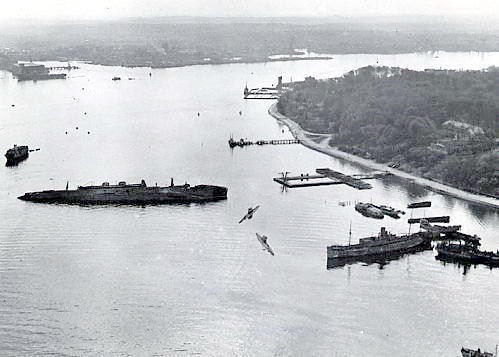
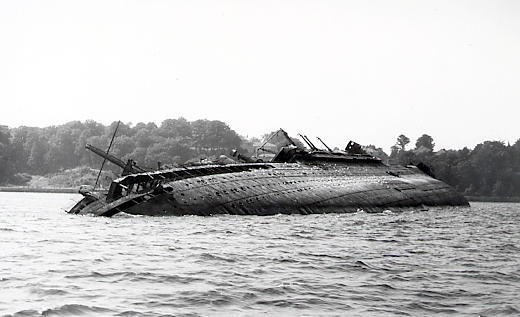
The capsized wreck of the SS New York.
https://www.wlb-stuttgart.de/seekrieg/45-04.htm
https://www.wlb-stuttgart.de/seekrieg/45-04.htm
Dinner aboard the Cap Arcona. June 14th, 1938. The names on the back of the postcard are Pablo Comino, Blanquita, Sol-edad Julio, and Angel Rocen.
Letter sent to the Cap Arcona in her final days.
Feldpost envelope sent to sailor Adolf Dronski on board the Cap Arcona via Hamburg. (Unfortunately missing the original letter). It was sent on March 10th, 1945, after the ship finished her first of 3 evacuation runs from Gotenhafen (Gdynia) to Copenhagen. Her final voyage left Copenhagen on March 27, then Gotenhafen on March 30, and arriving in Denmark on April 5. She was finally placed in Lübeck Bay where she would be bombed in less than 2 months with the loss of nearly 5,000. Adolf survived, as the envelope came with two pay slips and a pension receipt from 1947.
Feldpost envelope sent to sailor Adolf Dronski on board the Cap Arcona via Hamburg. (Unfortunately missing the original letter). It was sent on March 10th, 1945, after the ship finished her first of 3 evacuation runs from Gotenhafen (Gdynia) to Copenhagen. Her final voyage left Copenhagen on March 27, then Gotenhafen on March 30, and arriving in Denmark on April 5. She was finally placed in Lübeck Bay where she would be bombed in less than 2 months with the loss of nearly 5,000. Adolf survived, as the envelope came with two pay slips and a pension receipt from 1947.
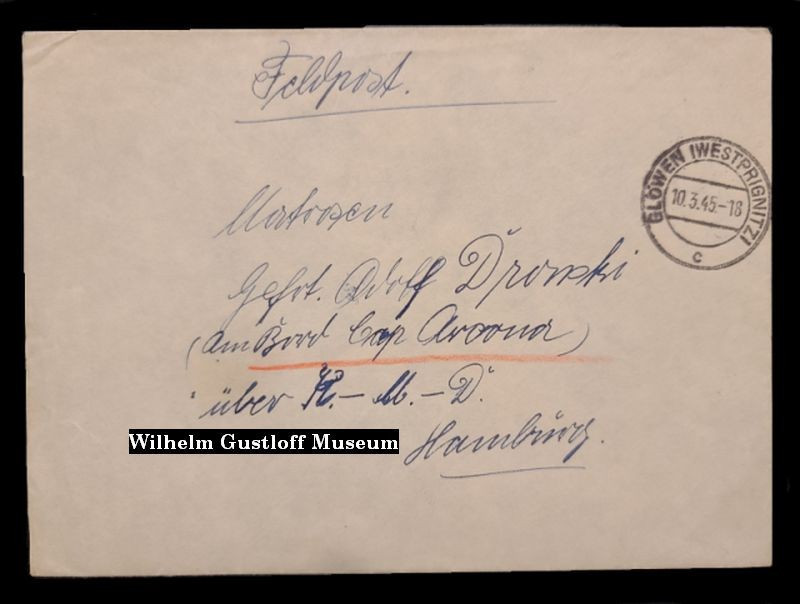
German Reich Sailor's Discharge Book #5 - Issued in Hamburg, 6/28/1929
This log book belonged to Gerhard Köster born in 1912. In addition to several Wilhelm Gustloff entries, he was aboard the Cap Arcona for a year and a half:
Cap Arcona - 8/30/33 to 3/2/35 - Kapitän Robin? Roliu?
I am really unsure of the captain's name - if anyone knows, please email me from the introduction page. Thanks!
I am really unsure of the captain's name - if anyone knows, please email me from the introduction page. Thanks!
Death card for Andre Jozef Christiaens.
Born March 20th, 1922, he was one of the Neuengamme prisoners transferred to the Cap Arcona, where he lost his life on May 3rd, 1945 in the bombing and fires.
Born March 20th, 1922, he was one of the Neuengamme prisoners transferred to the Cap Arcona, where he lost his life on May 3rd, 1945 in the bombing and fires.
HSDG oval plate taken from the Cap Arcona sometime during her career. Someone wrote the information on the back in a red marker to remember. The same plates can be seen under the cart used on deck in these photos from Alamy.
Random photos of German ships during World War 2:
#1-3: The wreck of the French liner Champlain in 1940 after striking a mine.
#4-5: The Monte Rosa, and two images of what is said to be her bow.
#6-8: The liner SS Hamburg in Danzig.
#9-11: The liner Monte Rosa during the war.
#12: Either the Deutschland, New York, or Hamburg.
#1-3: The wreck of the French liner Champlain in 1940 after striking a mine.
#4-5: The Monte Rosa, and two images of what is said to be her bow.
#6-8: The liner SS Hamburg in Danzig.
#9-11: The liner Monte Rosa during the war.
#12: Either the Deutschland, New York, or Hamburg.
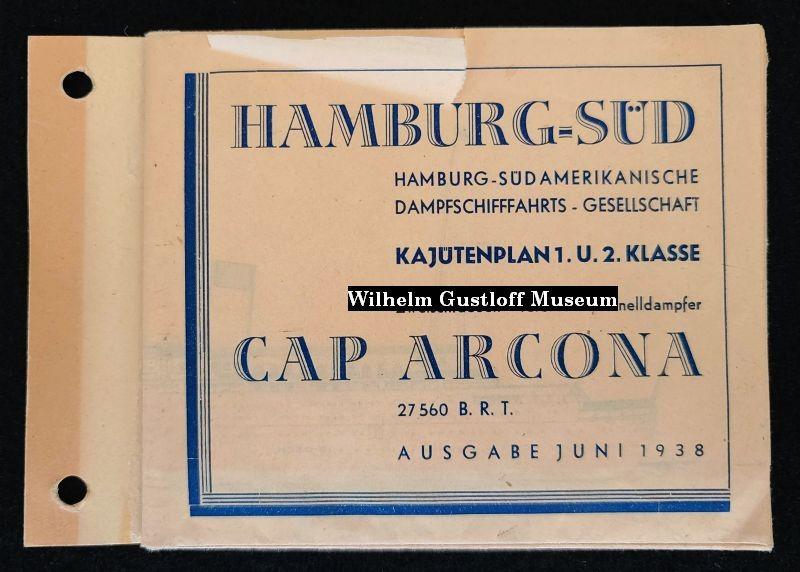
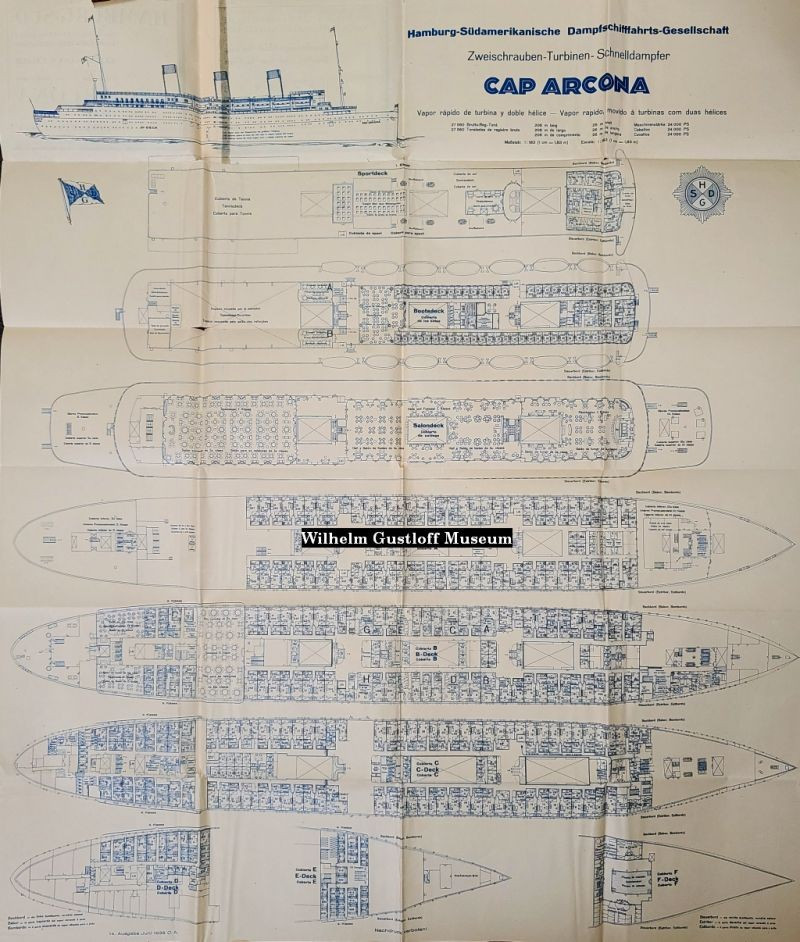
Cap Arcona Tissue Paper Deck Plans
Issued June 1938.
Issued June 1938.
Single album page of photographs and what appear to be photograph negatives but inverted of the Cap Arcona. The text says, "Cap Arcona passing the Cap Verde in the North Sea. These came with the deck plans shown above, so likely dated 1938.
Cap Arcona Photo Album, Loose Pages
North Sea Voyage
June 23rd to 28th, 1932
The New York in happier times.
Werft Reederei Hafen, July 7th, 1927.
Donated by Russell Smith.
Werft Reederei Hafen, July 7th, 1927.
Donated by Russell Smith.
Large Werft Reederei Hafen book, 1927.
Features almost everything you wish to know about the building of the Cap Arcona. Deck plans to machine diagrams, public room photographs, to previously unseen images of the ship and her construction. Generously donated by Russell Smith.
Features almost everything you wish to know about the building of the Cap Arcona. Deck plans to machine diagrams, public room photographs, to previously unseen images of the ship and her construction. Generously donated by Russell Smith.
Set of Cap Arcona souvenir photographs.
Dated: Gotenhafen, 4/27/1943.
Dated: Gotenhafen, 4/27/1943.
Images from a ceremony on the side hull of the wreck of the Cap Arcona. Source
Wreck divers go into the wreck of the Cap Arcona to recover items. Source
A second death card for Eugeen-Jacques Van de Weghe. Born September 20th, 1904, and died aboard the Cap Arcona May 3rd, 1945.
World War 2 Cap Arcona Photo Album
A seldom seen look into life on board the Cap Arcona from 1943 while in Gotenhafen (Gdynia). A photo album of the Marine-Helferin with several images of the girls on deck, on the ship's gangway, and one or two taken inside cabins and the ship in general. There are several other war images in the album of other Kriegsmarine ships, Danzig, Kiel & Laboe, U-boats, including U-33, and the ship Arica. Some loose photos were marked on the back over the summer of 1943, but I have not seen any dated from 1944 or 1945.
A seldom seen look into life on board the Cap Arcona from 1943 while in Gotenhafen (Gdynia). A photo album of the Marine-Helferin with several images of the girls on deck, on the ship's gangway, and one or two taken inside cabins and the ship in general. There are several other war images in the album of other Kriegsmarine ships, Danzig, Kiel & Laboe, U-boats, including U-33, and the ship Arica. Some loose photos were marked on the back over the summer of 1943, but I have not seen any dated from 1944 or 1945.
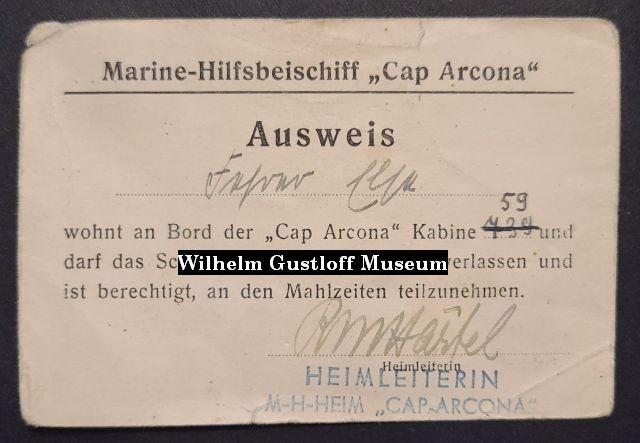
Also featured in the photo album is a "Naval auxiliary ship 'Cap Arcona' ID card. Fehrer, Elsa lives on board "Cap Arcona" cabin (739) 59 and may enter and leave the ship at any time and is entitled to take part in meals. (Unknown signature) Head of the M-H-Heim "Cap Arcona"
Both cabins were located on C-Deck on the port side of the ship. Based on the deck plans I have, one of the album images was taken inside cabin 59, having the desk replace where the bed once was.
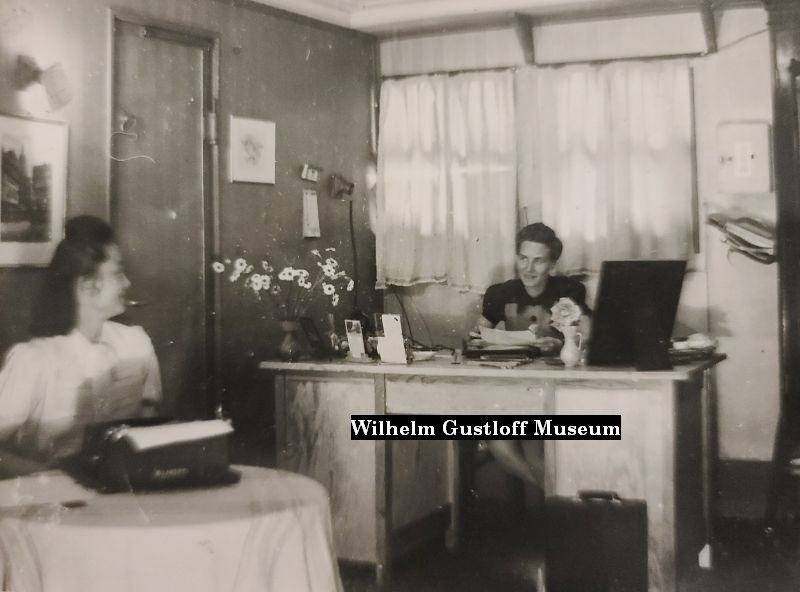
The New York bombed out.
A very large group photo aboard the Cap Arcona.
A set of photographs taken of and aboard the Cap Arcona in 1940 / 1941. The first shows a great view of the ship from her stern, while the second shows from her bow. The Antonio Delfino is in the next two images, followed by shots taken from her forward deck. These show the ships Deutschland (I previously thought this was the New York until someone pointed out the number of masts), the Hansa, Wilhelm Gustloff, and an unknown ship in camouflage along with a u-boat.
Souvenir Cap Arcona ship wheel pin purchased aboard the liner.
HSDG / Hamburg Süd / Hamburg Südamerikanische Dampfschifffahrts-Gesellschaft Silver Coasters
Three stunning HSDG silver coasters made by Wellner, but only two are marked. Each measuring 3 3/4" across, these come apart for cleaning and elaborately spell out the initials of the line. Probably among the most beautiful pieces made for HSDG. These same style coasters were recovered from the wreck of the Monte Olivia in 2022 / 2023 - the last three photos on the right.
With that, I assume these were aboard all Monte class ships. Perhaps these are survivors of the Monte Rosa? Hard to say, but among my top favorite pieces made for the line!
Three stunning HSDG silver coasters made by Wellner, but only two are marked. Each measuring 3 3/4" across, these come apart for cleaning and elaborately spell out the initials of the line. Probably among the most beautiful pieces made for HSDG. These same style coasters were recovered from the wreck of the Monte Olivia in 2022 / 2023 - the last three photos on the right.
With that, I assume these were aboard all Monte class ships. Perhaps these are survivors of the Monte Rosa? Hard to say, but among my top favorite pieces made for the line!
HSDG Silver Recovered from the wreck of the Monte Olivia.
An original HSDG coffee pot recovered from the wreck of the Monte Olivia in 1947 during her scrapping by a friend of the family I purchased it from. Measuring 8" high and 12" across, this battered piece comes with the original lid, though now disconnected. From 1940 until shortly before the end of the war in 1945, the Monte Olivia was first used as an accommodation ship for the German Navy and then converted into a hospital ship. After several bombs hit the ship and tore open the side, the ship capsized on April 3, 1945 in the Scheerhafen in Kiel. Souvenirs were taken while the ship was scrapped and more were thrown overboard in the process.
In 2022, divers found over 300 pieces of silver from the ship in all different states - some badly damaged, some looked like they were brand new. Several examples of this pot were recovered from the wreck - shown below starting at photo 10. I also have a few photos from a voyage aboard the Monte Olivia from June 9th to 14th, 1937. One of these photos shows the same coffee pot on the dining room table, along with other silver and the marked HSDG china. Simply a fantastic piece of history!
An original HSDG coffee pot recovered from the wreck of the Monte Olivia in 1947 during her scrapping by a friend of the family I purchased it from. Measuring 8" high and 12" across, this battered piece comes with the original lid, though now disconnected. From 1940 until shortly before the end of the war in 1945, the Monte Olivia was first used as an accommodation ship for the German Navy and then converted into a hospital ship. After several bombs hit the ship and tore open the side, the ship capsized on April 3, 1945 in the Scheerhafen in Kiel. Souvenirs were taken while the ship was scrapped and more were thrown overboard in the process.
In 2022, divers found over 300 pieces of silver from the ship in all different states - some badly damaged, some looked like they were brand new. Several examples of this pot were recovered from the wreck - shown below starting at photo 10. I also have a few photos from a voyage aboard the Monte Olivia from June 9th to 14th, 1937. One of these photos shows the same coffee pot on the dining room table, along with other silver and the marked HSDG china. Simply a fantastic piece of history!
HSDG SIlver Coffee Pot
A large silver-plated coffee pot from the 1st Class service of Hamburg South America Line’s Cap Polonio. Marked H.S.D.G., and made by Krupp Berndorf with the date stamp of 1927 - 1933. Possibly made for her rebuild in 1931, she was soon laid up and never resumed passenger service. Measures almost 9.5" tall, 7.5 across at the top with handle. Quite a heavy piece! Finally, she was sold for scrap on June 21st, 1935 to M. Stern A.G., Essen and scrapped in Bremerhaven. Parts of the ship, including her dining room, still survive in Pinneberg at the Hotel Cap Polonio. A portion of her silver service went to Barmherzigen Brüder (Bavarian Order "Brothers of Mercy".) This is one of those pieces that was auctioned off. Shown with a beautiful large 14x8" fold out travel brochure for the ship.
A large silver-plated coffee pot from the 1st Class service of Hamburg South America Line’s Cap Polonio. Marked H.S.D.G., and made by Krupp Berndorf with the date stamp of 1927 - 1933. Possibly made for her rebuild in 1931, she was soon laid up and never resumed passenger service. Measures almost 9.5" tall, 7.5 across at the top with handle. Quite a heavy piece! Finally, she was sold for scrap on June 21st, 1935 to M. Stern A.G., Essen and scrapped in Bremerhaven. Parts of the ship, including her dining room, still survive in Pinneberg at the Hotel Cap Polonio. A portion of her silver service went to Barmherzigen Brüder (Bavarian Order "Brothers of Mercy".) This is one of those pieces that was auctioned off. Shown with a beautiful large 14x8" fold out travel brochure for the ship.
A few other pieces of HSDG history. First up, a cut glass pitcher with the HSDG logo etched into the front. Measuring 8" tall and 5" across at the base, there aren't any flaws in it that I can see. While I have no idea when this dates to, I imagine it's around the 1910s or 20s. How many glass items do you see these days that have survived 100 years!
Next is a small HSDG desk calendar that rotates to change the date, followed by a bronze commemorative coin created in 1914 for the maiden voyage of the Cap Trafalgar. The liner would only sail for a few months before being swept into WW1 and sunk in a battle against the Carmania.
Finally, Jack London's Lockruf des Goldes, or Call of Gold. Originally Burning Daylight. Upon opening the front cover, this is actually a book that once belonged in the on board library of an HSDG ship. There is no publication date, so it is impossible to narrow down which ship it may have been on. Remains of a cover are evident as well. The tag basically reads as follows:
Next is a small HSDG desk calendar that rotates to change the date, followed by a bronze commemorative coin created in 1914 for the maiden voyage of the Cap Trafalgar. The liner would only sail for a few months before being swept into WW1 and sunk in a battle against the Carmania.
Finally, Jack London's Lockruf des Goldes, or Call of Gold. Originally Burning Daylight. Upon opening the front cover, this is actually a book that once belonged in the on board library of an HSDG ship. There is no publication date, so it is impossible to narrow down which ship it may have been on. Remains of a cover are evident as well. The tag basically reads as follows:
Bookplate Hamburg Sud - Library Regulations
The ship's library is available to all passengers free of charge. Books are issued only against receipt, and no single book can be returned to more than one passenger at a time. Books may only be taken from the library after the book has been borrowed. Passengers are strongly advised to treat books with care, and they are especially requested not to leave them in the lounges or on deck and to return them to the library steward as soon as possible after reading. Readers who cause loss or damage to books are liable for any resulting damage.
A lot of photos from the famous liners Europa & Bremen.
1 - The Europa being fitted out prior to her fire.
2 & 3 - The Europa and Bremen in their camouflage paint.
4 - Press photo on the fire aboard the Bremen.
5 & 6 - Personal photographs of the Bremen burnt out at her dock.
7 & 8 - The Europa as the USS Europa at the end of the war.
1 - The Europa being fitted out prior to her fire.
2 & 3 - The Europa and Bremen in their camouflage paint.
4 - Press photo on the fire aboard the Bremen.
5 & 6 - Personal photographs of the Bremen burnt out at her dock.
7 & 8 - The Europa as the USS Europa at the end of the war.
Cap Arcona Travel Brochure